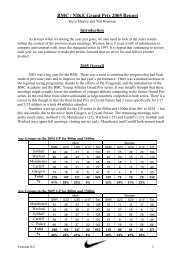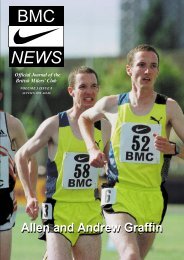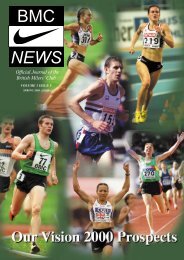Autumn 2007 - British Milers Club
Autumn 2007 - British Milers Club
Autumn 2007 - British Milers Club
- No tags were found...
Create successful ePaper yourself
Turn your PDF publications into a flip-book with our unique Google optimized e-Paper software.
Olympics apart, has dominated herraces by huge margins and has run herown race plans and set gruelling pacesthat no one else could match whichshows how confident she is in her ownphysical and mental strengths.Cross CountryThis discipline is different to trackevents and usually there are no ‘cat andmouse’ tactics with races mostly run atan ‘honest’ pace. Invariably crosscountry races start off fast and the frontrunners pursue a hard pace throughouttrying to drop the opposition throughbetter strength levels or breaking awayon an uphill or downhill section of thecourse. However, pace judgement isimperative for success with racingdistances much longer for the 800mand 1500m specialists. Those in theleading pack especially will use somekind of ‘sit and wait’ tactics, decidingwhether to wait until the final 100m -400m or make a break with 800m ormore to go. A common way of breakingaway from the pack is to keep an eyeon the opposition’s body language, arethey suddenly breathing hard, are theyslowing down dramatically on a hill forexample?Whereas breaks from the opposition onthe track are usually positive, decisivemoves, on the country these breaks canbe subtle and more of a ‘wearing down’of the opposition and also demoralisingthem on a certain section of the course.Obviously the size of the entrants forcross country events can vary fromaround 50 to 3000 competitors andbecause of this and the nature of thecourse, getting into a reasonableposition after the start is very importantfor a positive result. The pace in crosscountry varies immensely with uphills,downhills, turns and underfootconditions and because of this asmooth steady run cannot be expectedand an athlete could be running at 4-20 mile pace at some stage and 6-20mile pace at others!A useful tactic in cross country races isto try and get 15m-20m on a rivalgoing up a hill and make a huge effortoff the top of the hill and try to keep itgoing for at least another 400m andthe 15m-20m can quite easily grow to50m or more due to the rival gettingdisheartened. In track races once thefield has settled everyone is running inthe confined space of one lane, but incross country the leading bunch can bespread over a much wider area andconcentration may be even moreimportant with a fixation on the leadersand also the course geography.Finishing speed is just as important asin track events and even after 12k itmay come down to the final 50m todecide the medals. Most cross countryspecialists are usually successful 5kand 10k track specialists and both thewinter and summer disciplines cancompliment each other. The pace thetop athletes run over firm, muddy, flator hilly courses is phenomenal and thespeed over the closing stages can bebrutal and to watch someone likeBekele is an education in itself. Ialways tell athletes and coaches alike towatch him at his best from the hipsdown and you would swear he wasrunning on a track and not strengthsapping grass and mud.OverviewGoing back to the start of this articleand summing up tactics as a means ofachieving an objective and a plan orskill to trick your competitors, it is clearthat a race is akin to a game of chesswith the moves to win similar, but howthey unfold depends on the oppositionand how you approach the event.Pre-race tactics or in some cases‘gamesmanship’ by fair means can beused to fool the opposition into a falsesense of superiority and these can bethe tricks in an athletes repertoire.Dialogues with other athletes conningthem into believing that you’ve beeninjured or ill and haven’t trained candupe them into believing that they willhave no problems in beating you. I’msure sprinters deliberately false start toupset certain competitors and haveplanned those manoeuvres weeksbefore to unsettle their rivals. Throwersmay intentionally throw a big practicethrow or a poor throw before thecompetition starts to mislead theentrants of the actual outcome. Someathletes warm-up in a different place towhere the opposition are and only getto the start line when necessary, thiscan elate or deflate the opposition andput their tactical plans in tatters. Otherathletes will appear arrogant, nontalkative,unfriendly in the warm-upzone, so the athlete must learn how todispel any negativity from thesemannerisms. It’s all kidology of course,but as long as it’s fair, it is part andparcel of tactical psychology. Athleteshave to be one step ahead of theopposition physically and mentally andit is often said that a race is won andlost in the warm-up area.Whatever race distance you run, if youare leading entering the home straight,stick to the inside lane and don’t movefrom it! It is amazing how manyathletes drift into the second lane andallow a hopelessly boxed in athlete afree run to the tape.Train hard and get in fantastic physicalshape but think long and hard how youwill get the best out of yourself andhow you will react to different situationsin competitions, in other words beready for anything!22 BMC News : <strong>Autumn</strong> <strong>2007</strong>















